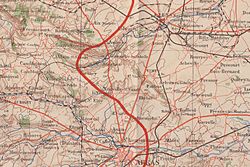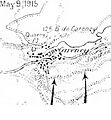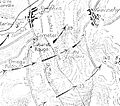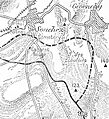Second Battle of Artois facts for kids
Quick facts for kids Second Battle of Artois |
|||||||||
|---|---|---|---|---|---|---|---|---|---|
| Part of The Western Front of the First World War | |||||||||
 Western Front, Artois: Arras sector, January 1915 |
|||||||||
|
|||||||||
| Belligerents | |||||||||
| Commanders and leaders | |||||||||
| Joseph Joffre Victor d'Urbal Douglas Haig |
Crown Prince Rupprecht of Bavaria | ||||||||
| Strength | |||||||||
| 9 French and British divisions (initial) 20 divisions (final) |
18 divisions (final) | ||||||||
| Casualties and losses | |||||||||
| French: 102,500 British: 27,809 (Aubers Ridge: 11,161, Festubert: 16,648) |
Germany: 73,072 | ||||||||
The Second Battle of Artois was a major fight on the Western Front during the First World War. It happened in France, near a place called Artois, from May 9 to June 18, 1915. The main goal for the French and British armies was to push back the German forces. They wanted to cut off German supply lines, especially the railways that helped their armies in the north.
The French army, led by General Joseph Joffre, planned to attack a strong German position called Vimy Ridge. At the same time, the British army, led by Field Marshal Sir John French, planned attacks further north at Aubers Ridge and Festubert. The battle was very tough and costly for both sides, with lots of fighting in trenches.
Why the Battle Happened
The War So Far
After some earlier battles in 1914, the fighting on the Western Front had become a trench war. This meant soldiers lived and fought from long ditches dug into the ground. Neither side could easily move forward. The French wanted to break through the German lines. They hoped to free parts of northern France that the Germans had taken over.
The German army, led by General Erich Von Falkenhayn, also worked to make their defenses stronger. They built more trenches and added barbed wire. They also used machine guns and heavy artillery (big guns) to stop attacks. Both sides were trying to find new ways to win this type of war.
Plans for Attack
General Joffre believed that a big attack was needed. He wanted to capture Vimy Ridge, a high piece of land that gave the Germans a good view of the area. If the French could take it, they could then move into the flat plains beyond and cut German railway lines.
The British agreed to help by attacking further north. Their goal was to keep German soldiers busy so they couldn't move to help defend Vimy Ridge. Both armies hoped to surprise the Germans and break through their strong defenses.
Getting Ready for Battle
French Preparations
The French spent a lot of time getting ready. They dug tunnels under German positions and placed explosives. They also brought in many heavy guns and lots of ammunition. The main attack areas were the Lorette Spur (a hill) and a complex network of trenches called the Labyrinthe.
General d'Urbal took command of the French Tenth Army. He had many soldiers and guns ready. The French planned a long artillery bombardment (shelling) to weaken the German defenses before their soldiers attacked. This bombardment lasted several days, causing a lot of damage to the German front lines.
German Preparations
The Germans had also been busy making their defenses even stronger. They added more barbed wire and built concrete strong points. They turned villages like Neuville St Vaast and Carency into underground fortresses, with tunnels and fortified houses.
The German 6th Army had many soldiers and guns ready to defend their positions. They knew an attack was coming. They used their artillery and machine guns to cover all the ways the French might try to advance.
The Battle Begins
First Attacks (May 9–20)
On May 9, the battle started with a huge French bombardment. Mines were exploded under German lines. Then, French soldiers attacked.
- Lorette Spur: French soldiers captured some trenches on the Lorette Spur, but faced heavy machine-gun fire.
- Carency: The French took the German trenches at Carency. They tried to push into the village but were stopped by strong German fire.
- Vimy Ridge: Some French troops, especially the Moroccan Division, made a big push and reached Vimy Ridge. This surprised everyone! However, they were in a narrow area and faced attacks from all sides. German counter-attacks forced them back from the ridge.
- La Targette and Neuville: The French quickly captured La Targette and entered Neuville St Vaast. They fought hard, taking about half of the village.
The British also attacked on May 9 at Aubers Ridge. Their attack was very difficult and costly. They faced heavy German machine-gun fire and couldn't break through. This attack failed, and many British soldiers were injured or killed.
By the end of the first day, the French had taken some ground and many prisoners. But they had also suffered many casualties. The Germans quickly brought in more soldiers to stop the French advance.
Fighting Continues (May 12 – June 12)
After the first day, the battle became a series of smaller, very tough attacks. The French tried to capture key German strongholds like Carency, Ablain, Souchez, and Neuville.
- Carency and Lorette Spur: The French slowly captured Carency and most of the Lorette Spur. This was very difficult fighting, often hand-to-hand. The area was full of dead soldiers from earlier fighting, making conditions terrible.
- Neuville and the Labyrinthe: Fighting in Neuville St Vaast and the Labyrinthe was especially fierce. These areas were like underground fortresses. The French made slow progress, facing constant machine-gun fire and counter-attacks.
The British also continued their attacks at Festubert from May 15. They used more artillery to prepare their attacks. They managed to push the Germans back a little, but it was also very costly. These British attacks helped the French by keeping German soldiers busy in the north.
The French command realized that their attacks were too rushed. They decided to pause and prepare more carefully. They focused on taking smaller, specific targets with strong artillery support. This helped them gain more ground, but it was still very slow and hard.
Final Push (June 13–18)
After weeks of fighting, the French prepared for another big attack in mid-June. They brought in even more artillery and ammunition. They planned to use new tactics, like a "creeping barrage," where artillery fire moves forward slowly, just ahead of the attacking soldiers. They also used some gas and incendiary (fire-starting) shells.
On June 16, the French attacked again.
- Vimy Ridge: The attacks on Vimy Ridge were very difficult. The German defenses were still strong, with lots of barbed wire and hidden dugouts. Many French soldiers were stopped by heavy fire and couldn't advance.
- Souchez and Neuville: Fighting continued in Souchez and Neuville. The French made some gains, but the Germans fought back fiercely. German artillery was very effective at stopping French advances.
The British also launched smaller attacks to help, but they also faced strong German defenses and suffered many casualties. By June 18, the French realized they couldn't break through. The main offensive was stopped.
Aftermath
The Second Battle of Artois was a very costly battle for both sides.
- The French suffered about 102,500 casualties (soldiers injured or killed).
- The British had about 27,809 casualties.
- The Germans lost about 73,072 soldiers.
The French managed to gain about 16 square kilometers of land. The British also advanced a small amount at Festubert. However, the main goal of capturing Vimy Ridge and breaking through the German lines was not achieved.
This battle taught the French army important lessons about trench warfare. They learned that they needed even more machine guns and better artillery tactics. They also realized that breaking through strong defenses was much harder than they thought. These lessons helped them plan future battles on the Western Front. A quiet period followed in the area until the Third Battle of Artois in September.
Images for kids


















